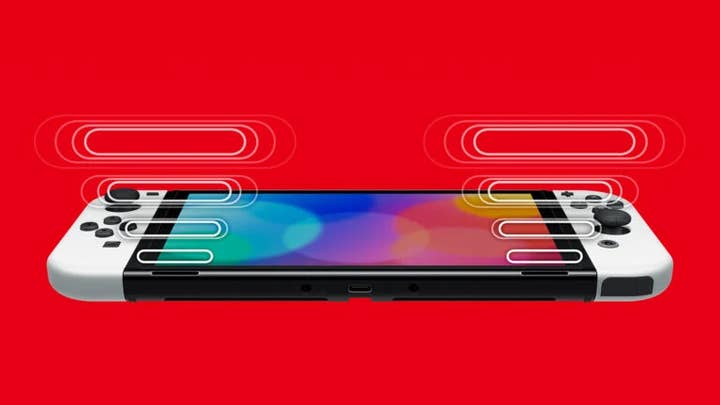Nintendo's Switch strategy is increasingly handheld-focused | Opinion
The OLED Switch may not be the new hardware some consumers hoped for - but it's a good signal of Nintendo's strategy and the new markets it hopes to win over
Ask almost anyone who works in a public- or client-facing business role -- whether it's financial, marketing, sales, PR, or any form of executive position that occasionally involves popping your head above the parapet -- what the key objectives of their job actually are, and you'll probably not get very far down the list before you hit the phrase "managing expectations."
It's a phrase that has more than a tinge of newspeak about it, but the central concept is really as simple as it sounds; almost any job where you're dealing with people outside your own company (and many entirely internally-focused jobs, for that matter) comes with a really important need to ensure that those people's expectations are being appropriately set and adjusted. Whether it's investor expectations about your upcoming financial results, partner company expectations about your installed base growth, consumer expectations about your release pipeline, client expectations about your delivery dates... "Under-promise and over-deliver" is a mantra plenty of us have heard, and it's certainly applicable in many instances, but there are just as many roles where the real challenge is making sure everyone is on the same page about what's actually being promised.
Leaks are inevitable, and leaks beget rumours, and rumours, well, they beget expectations
For consumer-facing companies, managing the expectations of their customers and the public at large has become increasingly complex in the past few decades. The Internet has given PR and marketing teams more powerful tools than ever before to measure, shape and influence public opinion and expectations; it's also, however, turned the territory they work on into something inherently unpredictable, rapidly changing, and filled with actors entirely beyond their control. Companies have taken different approaches to how they deal with this problem; some have opted to be radically open, sharing as much information as they can about their product pipeline and future plans in order to try to maintain some degree of control over consumer expectations. Others, perhaps most notably Apple, have clamped down hard on leaks and tried to play their cards closer to their chest than ever, hoping that an information blackout will prevent rumours and speculation from turning into concrete expectations.
Nintendo, I think, sees itself as being on the Apple side of this equation. It plays its cards close to its chest, rarely reveals anything until it's good and ready, and for the most part, it's pretty good at this -- still capable of pulling out major surprises on the software front, at least. On the hardware side, however, this is a much harder game to play, and Nintendo isn't especially good at it. Developing and launching new hardware requires collaboration with a hell of a lot of different companies and brings hundreds if not thousands of people into the loop. Leaks are inevitable, and leaks beget rumours, and rumours, well, they beget expectations.
Which is all a pretty long-winded way of saying that Nintendo announced a new version of the Switch this week, and despite being a pretty nice little update to the console's hardware, it was greeted with a largely negative reaction and a thumping to the company's share price -- because it didn't match the expectation that had built up for the company's next hardware plans. Expectations that had been set, I should add, completely without Nintendo saying anything; this week is the first time the company has even hinted at revised Switch hardware. Everything else is a matter of leaks and reports that had built up to a pretty clear picture of a "Switch Pro" model being in the works -- reports that had become expectations, expectations that had solidified in the minds of some consumers and investors into accepted facts.

What we actually got, in the form of a display update to OLED, is a disappointment only in comparison to those expectations. The Switch Pro almost certainly does exist in one form or another -- there's enough information from enough independent sources to make that relatively certain, though whether it was ever intended to release in 2021 or whether people got their wires crossed over the OLED model also winding its way through pre-production is an open question. There's a solid argument to be made, however, that Nintendo is both pretty happy with the current sales of Switch (thus feels no need to try to trigger an upgrade cycle for existing users) and in no mood to throw itself into the fray of trying to get a supply chain running for a new chipset in the current semiconductor shortage. The strategic reasoning for keeping the powder dry on a more full-scale upgrade to the Switch seems sound to me.
With Switch still selling fantastically but with the fallout of COVID being seen in a slightly sparse software pipeline, this year wouldn't have been an optimal time for [Switch Pro]
What's arguably most interesting about the OLED Switch, however, isn't the disappointment it's spurred among both investors and core consumers -- neither of which is really likely to matter if the revision does what it's supposed to do and gives the console a nice sheen of new-ness just in time for more casual consumers to start thinking about their winter and Christmas purchases. Rather, it's what it tells us about Nintendo's strategy, and how Nintendo itself sees the Switch -- because this revision is very much a handheld revision, in terms of how it sits with Nintendo's history of hardware revisions, and that has implications for the platform's future.
Certainly, the OLED Switch isn't the full-on handheld-only update we saw with the Switch Lite -- which dropped all the docked play features from the console entirely to turn it into a pure handheld -- but it's also an update that doesn't make very much sense at all unless you're primarily playing in handheld mode. A few relatively minor details aside, the only major upgrade here is an overhaul of a screen that's hidden behind plastic when docked. It may not be a pure handheld device like the Lite, but it seems meaningful that the Switch is now two-for-two on hardware updates that are entirely focused on the console's undocked, handheld functionality.
Indeed, if we look beyond the hardware specifics, the hardware strategy that's coming into focus for this platform overall is much, much more "handheld-like" than we had perhaps expected. One of the core differences between Nintendo's home consoles and its handheld devices is that the company tinkers relentlessly with the latter; where its home consoles generally don't change much in hardware terms from one end of their lifespan to the other (peculiarities like the Wii Mini notwithstanding), its handhelds are updated over and over again across their time on the market, and commonly have multiple versions of the hardware on store shelves simultaneously.
The OLED update for the Switch is absolutely in keeping with more minor "bump" hardware updates for Nintendo's past handhelds -- it doesn't do anything new and it's not going to drive anyone but the most devoted of fans out there to replace their existing Switch, but it's a solid improvement that will boost the console's appeal to new purchasers. Moreover, if this is the path we're on -- with the Switch being regularly tweaked and updated into new forms, as Nintendo's handhelds always have been -- then the possibility of a Switch Pro and other exotic new models of the hardware in the years to come remains very much alive.

The implication that Nintendo regards the Switch as a handheld console in strategic terms shouldn't be over-interpreted -- the company isn't about to "abandon" docked play or anything drastic like that, and it's worth noting that its marketing for the Switch still tends to focus heavily on the docked aspects of the console's functionality. However, it's suggestive of the approach we're likely to see to the new demographic markets it's entering as the Switch installed base grows. Successful consoles inevitably move into more casual, less devoted groups of consumers as they seek out new audiences to keep their sales curve looking health, and for Switch, those groups seem likely to look more like handheld players than console players.
The advent of smartphones means Nintendo will never recapture the Game Boy market as it once was, of course -- but the company's focus on improving the handheld aspects of its hardware implies that it has identified a potentially huge "semi-casual" market of consumers for whom taking over the living room TV for a big-screen gaming extravaganza is a bit much, but whiling away some time on a device that's a big step up from a smartphone experience is absolutely in their ballpark.
The OLED Switch, much like the Lite before it, is largely aimed at that audience. It won't trigger an upgrade cycle for existing Switch owners -- but Nintendo can keep that option in its back pocket for a time when it actually needs it. This year, with Switch still selling fantastically but with the fallout of COVID being seen in a slightly sparse software pipeline, wouldn't have been an optimal time for trying to capitalise on an upgrade cycle -- so instead Nintendo is fiddling around the edges and making its hardware seem fresh and interesting to more casual buyers.
It's unfortunate that the immediate reaction has been "this isn't the Switch Pro we wanted" -- and Nintendo would perhaps do well to learn some lessons about expectation management from that, because if you're not Apple (whose time periods between major announcements is short and whose capacity to brutally crack down on information leaks is legendary) then you can't manage expectations like Apple does, and if you're not out there setting expectations then someone else will be out there doing it for you.
Ultimately, though, those who are disappointed probably weren't in the intended audience anyway -- and as for the Switch Pro rumour mill, well, we can expect that to keep turning on for another few cycles, it seems.

